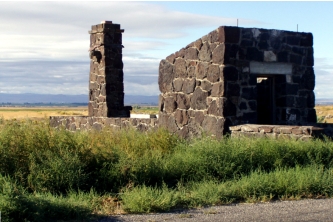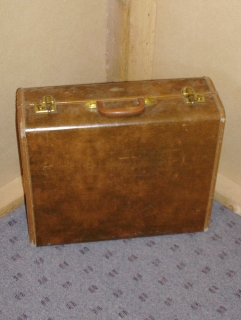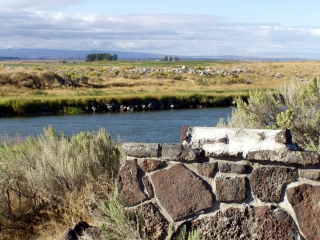NPS Website; Local Website;
 WHAT IS IT?
WHAT IS IT?This 33,000-acre Central Idaho site-in-progress commemorates the World War II-era, 1942-1945, forcible imprisonment of 13,000 American citizens of Japanese decent.
BEAUTY (4/10)
Remnants of stone walls from the entrance station and guard tower are all that stands amid fields of sagebrush. Privately owned farms outline the 73-acres set aside for the Monument. Large rounded boulders called “melon gravels” dot the landscape.
Residents of the Relocation Center managed to turn these arid and desolate fields of nothing into beautiful self-sustaining gardens through clearing and irrigation. Absent their care, the land has returned to its pre-Center state.
Several local farmers and private citizens have donated original buildings (dispersed via lottery after the Center shut down) to the Park Service. Some of these could be incorporated into the future site.
HISTORICAL INTEREST (7/10)
The site remembers what has been called the worst violation of Constitutional rights in American history. The Minidoka Relocation Center was a 33,000-acre site with over 600 buildings and 13,000 internees – more than two-thirds of them American citizens by birth. The Center was in operation for over three years, from August 1942 to October 1945 under the authority of Executive Order 9066, which allowed U.S. military to remove “any or all persons” from the West Coast.
The Minidoka Center, also known as Hunt Camp, housed Japanese Americans who were deemed “loyal” to the United States, based on answers to a “loyalty questionnaire”. Despite their loyalty, these citizens were still held against their will in substandard tarpaper housing surrounded by barbed wire and patrolled by guards. Those labeled at “disloyal” were sent to the Tule Lake camp in California. The largest forced relocation in U.S. history displaced over 120,000 persons of Japanese descent.
CROWDS (6/10)
We were alone at the Minidoka exhibit in Hagerman. Another young couple was with us at the actual Monument. Crowds did not affect our visit.
 EASE OF USE/ACCESS (1/5)
EASE OF USE/ACCESS (1/5)The Minidoka Internment NM will be located on the site of the old prison camp about 17 miles from Interstate 84 along Idaho Route 25 near the town of Jerome. Only a brick ruin of the camp’s entrance exists to date. A small exhibit dedicated to the Minidoka Site is located at the Hagerman Fossil Beds NM Visitor Center 42 miles to the west.
CONCESSIONS/BOOKSTORE (2/5)
Since Minidoka shares an already tight space with the Hagerman Fossil Beds NM, there are not many offerings in the communal bookstore. We counted eight titles, half of them memoirs or personal accounts of Japanese Americans who were interned. These books can be purchased online through the Craters of the Moon History Society.
COSTS (4/5)
The Site is free.
RANGER/GUIDE TO TOURIST RATIO (4/5)
The Ranger at the Hagerman Fossil Beds NM Visitor Center was equally knowledgeable about the Minidoka site. In fact, she built the Minidoka exhibit that occupies the corner of the Hagerman Center. All of our questions were answered by this Idaho native who was able to offer insight into the residents of her state and neighbors of the Relocation Center.
There are no Rangers at the site of the Monument as there are no facilities or services.
TOURS/CLASSES (3/10)
No tours are offered. There is a small television set in the Minidoka exhibit but the videos related to the Minidoka Internment NM were missing. The Ranger suspects a co-worker who is currently in China may have them in his possession.
The Minidoka exhibit contains black and white historical photos, a few personal effects donated by families of those interred and a wreath and mobile of origami swans from annual pilgrimages to the site.
NPS is still working on the General Management Plan for Minidoka which will shape the look of the Monument and how it will be interpreted to the public. Their progress on the plan, the reconstruction of the site and opportunities for public participation can be accessed online using the link above.
FUN (3/10)
Nothing fun about this ugly incident in American history. American citizens were stripped of their property and possessions and practically all rights promised to them by that sacred document, the Constitution, and very few of their fellow citizens batted an eye. Wartime hysteria dictated unsound public policy and the unquestioned removal of basic civil liberties. This is not ancient history.
 WOULD WE RECOMMEND? (5/10)
WOULD WE RECOMMEND? (5/10)The 1988 Civil Liberties Act offered a formal apology and restitution to those interned and created a fund to finance educational efforts about the internment so as to prevent the recurrence of any similar event. The NPS has an obligation to preserve our history – even the parts that we are not proud and is in the process of doing so here. We, as Americans, have an obligation to learn.
This site is still a work in progress. Although it is exciting to see the plans NPS and the Friends of Minidoka have for the Monument, it will most likely be several years before facilities and services are fully functional.
TOTAL: 39/80
www.usa-c2c.com
© 2004-06